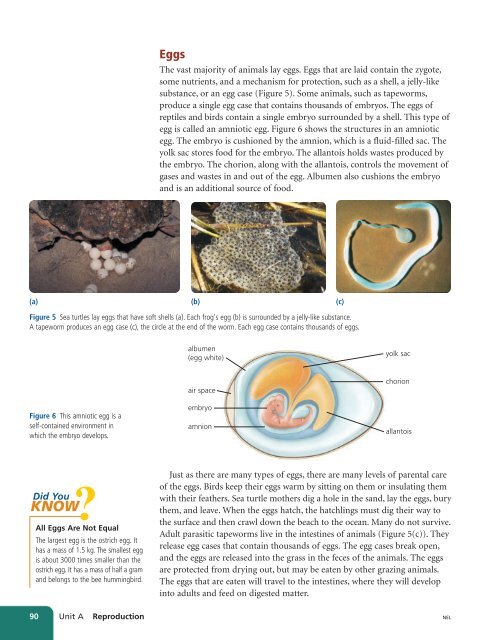Unit A Reproduction
Unit A Reproduction
Unit A Reproduction
You also want an ePaper? Increase the reach of your titles
YUMPU automatically turns print PDFs into web optimized ePapers that Google loves.
Eggs<br />
The vast majority of animals lay eggs. Eggs that are laid contain the zygote,<br />
some nutrients, and a mechanism for protection, such as a shell, a jelly-like<br />
substance, or an egg case (Figure 5). Some animals, such as tapeworms,<br />
produce a single egg case that contains thousands of embryos. The eggs of<br />
reptiles and birds contain a single embryo surrounded by a shell. This type of<br />
egg is called an amniotic egg. Figure 6 shows the structures in an amniotic<br />
egg. The embryo is cushioned by the amnion, which is a fluid-filled sac. The<br />
yolk sac stores food for the embryo. The allantois holds wastes produced by<br />
the embryo. The chorion, along with the allantois, controls the movement of<br />
gases and wastes in and out of the egg. Albumen also cushions the embryo<br />
and is an additional source of food.<br />
(a) (b) (c)<br />
Figure 5 Sea turtles lay eggs that have soft shells (a). Each frog's egg (b) is surrounded by a jelly-like substance.<br />
A tapeworm produces an egg case (c), the circle at the end of the worm. Each egg case contains thousands of eggs.<br />
albumen<br />
(egg white)<br />
yolk sac<br />
Figure 6 This amniotic egg is a<br />
self-contained environment in<br />
which the embryo develops.<br />
air space<br />
embryo<br />
amnion<br />
chorion<br />
allantois<br />
Did You<br />
KNOW?<br />
All Eggs Are Not Equal<br />
The largest egg is the ostrich egg. It<br />
has a mass of 1.5 kg. The smallest egg<br />
is about 3000 times smaller than the<br />
ostrich egg. It has a mass of half a gram<br />
and belongs to the bee hummingbird.<br />
Just as there are many types of eggs, there are many levels of parental care<br />
of the eggs. Birds keep their eggs warm by sitting on them or insulating them<br />
with their feathers. Sea turtle mothers dig a hole in the sand, lay the eggs, bury<br />
them, and leave. When the eggs hatch, the hatchlings must dig their way to<br />
the surface and then crawl down the beach to the ocean. Many do not survive.<br />
Adult parasitic tapeworms live in the intestines of animals (Figure 5(c)). They<br />
release egg cases that contain thousands of eggs. The egg cases break open,<br />
and the eggs are released into the grass in the feces of the animals. The eggs<br />
are protected from drying out, but may be eaten by other grazing animals.<br />
The eggs that are eaten will travel to the intestines, where they will develop<br />
into adults and feed on digested matter.<br />
90 <strong>Unit</strong> A <strong>Reproduction</strong><br />
NEL

















